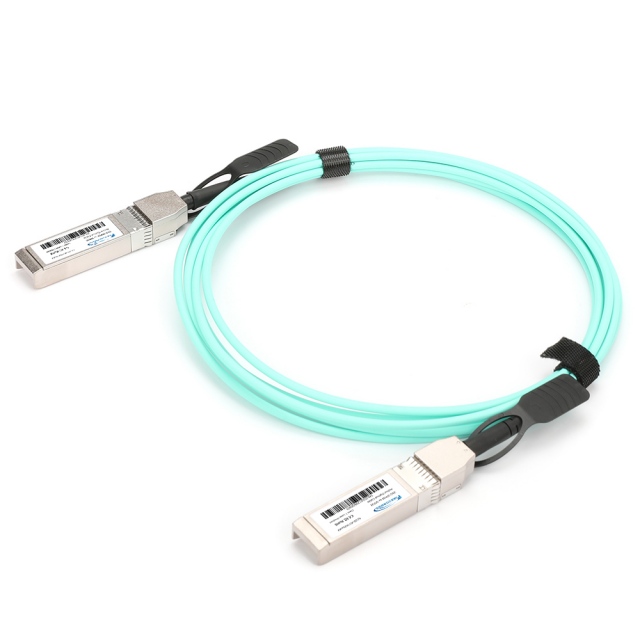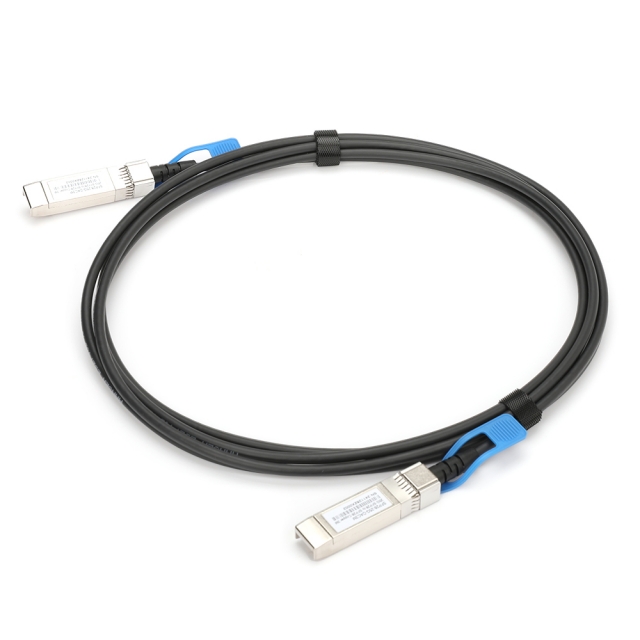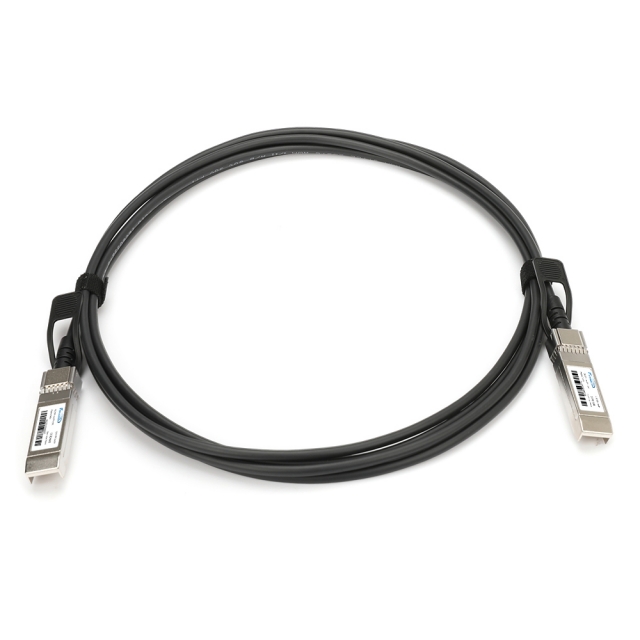25G SFP28 Direct Attach Cable Buying Guide
25G direct attach cables (DACs) are widely used to link servers, switches, and storage at 25 Gigabit Ethernet speeds. These 25G SFP28 DAC cables are copper twinax cables with SFP28 connectors on each end. They provide a high-throughput, low-latency connection over short distances (typically within a rack or between adjacent racks). Compared to optical fiber and transceivers, 25G DAC cable solutions offer excellent performance and cost benefits for short-range interconnects. When selecting a 25G DAC cable, data center managers should carefully evaluate several key factors to ensure reliable operation and value: performance and bandwidth, compatibility with equipment, cable length and attenuation, shielding and build quality, intended use cases, and overall cost-effectiveness.
Performance and Bandwidth Considerations
A 25G direct attach cable must reliably carry data at 25 Gigabits per second per lane. These cables use NRZ (non-return-to-zero) signaling at 25 Gbps and are specified by standards (such as IEEE 802.3by for 25 GbE) and form-factor specs like SFF-8402. In practice, a 25G SFP28 DAC cable will deliver full 25 Gbps throughput with very low added latency, since the signal stays in the electrical domain and bypasses any optical conversion. This means essentially no serialization delay beyond the cable length and very minimal power usage for passive cables. Many 25G DAC cables are also backward-compatible with 10 Gbps operation, allowing them to negotiate at lower speeds if necessary. When evaluating performance, check the cable’s data rate rating (must support 25 Gbps) and any equalization features for signal integrity.
Latency: Direct attach copper adds negligible latency compared to optics. This low latency is advantageous for high-performance computing and virtualization environments.
Signal Integrity: Quality 25G direct attach cable products maintain signal integrity via tight impedance control and limited skew. Premium cables use precision-twisted pairs and finely-tuned equalization so that bit error rates remain extremely low at 25 Gbps speeds.
Overall, a properly chosen 25G DAC cable will deliver line-rate performance with minimal overhead. Always verify with the manufacturer that the cable is rated for 25 Gbps (25GBASE-CR) operation and passes the relevant compliance tests (meeting SFF-8402 channel requirements).

Compatibility and Standards
Connector and Form Factor: All 25G SFP28 DAC cable products use the SFP28 transceiver form factor (similar in size to SFP+). Ensure that your switches, NICs, or routers have SFP28 ports; these ports are physically identical to 10 Gbps SFP+ ports but electrically support 25 Gbps. Many modern 25 GbE switches and network cards are multi-rate, accepting both SFP+ and SFP28 modules/cables. Still, double-check that the devices explicitly support 25G DAC cable operation at full speed.
Vendor and Interoperability: Some network equipment vendors require the use of certified (often branded) 25G direct attach cable products for guaranteed operation. Although DACs are typically standardized, compatibility can vary. For example, a cable from one vendor may not work in another vendor’s port if it lacks the correct EEPROM signatures. To avoid issues, choose cables labeled “multi-vendor compatible” or confirm with the switch/NIC documentation. Many third-party cable manufacturers publish compatibility lists. In practice, a generic 25G SFP28 DAC cable will work in any SFP28 port as long as it adheres to the SFF-8402 standard and has the correct MSA EEPROM data.
Standards Compliance: The IEEE 802.3by standard defines 25 GbE (25GBASE-CR) over copper. The SFF-8402 specification covers the physical interface for 25G DAC cable solutions. When shopping, look for cables explicitly stating compliance with these standards. This ensures proper signaling and compatibility. In addition, check any required features such as support for 10G/25G auto-negotiation, IEEE 802.3by or SFF-8402 marking, and operating temperature range. Properly spec’d cables will interoperate across different switch and NIC models, provided the form factor and speed are supported.
Cable Length and Signal Attenuation
One of the most important factors is length. Copper 25G direct attach cable products suffer attenuation (signal loss) that increases with length, limiting their usable range. Typical passive 25G DAC cable offerings range from 0.5 meters up to about 5 meters. Beyond roughly 3–5 meters, the signal degradation at 25 Gbps may exceed receiver equalization, depending on cable quality. For runs longer than 5 meters (and up to 7–10 m), many providers offer active DAC cables with built-in retimers or signal conditioners. These include small electronic components powered by the host, which boost the signal to extend reach. Active cables consume a bit more power (typically ~1 W) but can reliably reach 10 m or more.
Passive vs. Active: Passive 25G DAC cable products have no active electronics and are the most cost-effective. They are ideal for very short links (up to ~3 m). Active variants contain chips that compensate for loss, enabling longer lengths (often up to 7–10 m). When buying, note whether the cable is passive or active and choose based on needed distance.
Wire Gauge and Construction: Quality 25G SFP28 DAC cable designs use precise 24–30 AWG copper conductors. Thicker cables (lower AWG number) have lower loss and support longer distances but are less flexible. Some cables have different AWG segments along their length to balance flexibility with performance. The build quality (uniformity of twist rates, quality of copper plating, shielding layers, and connector soldering) all affect how well the cable maintains 25 Gbps signal integrity over length.
In summary, match cable length to use case: for rack-level connections up to 3 m, passive cables are ideal; for distances up to 7–10 m, consider active cables. Always test link reliability after installation, as marginal lengths or bends can sometimes cause bit errors at 25 Gbps speeds.
Shielding and Build Quality
At 25 Gbps, electromagnetic interference (EMI) and crosstalk become critical concerns. All 25G DAC cables should be fully shielded. Typically, each twisted pair is wrapped in foil and the entire cable bundle is braided with a grounded shield (commonly S/FTP construction). The SFP28 connector housings themselves are metal and provide continuous shielding from connector to cable. High-quality shielding ensures that external noise (from nearby power cables or fans) does not corrupt the high-speed signals.
EMI Protection: The twinax cable design and tight shielding minimize EMI. When selecting a 25G direct attach cable, look for descriptions such as “fully shielded” or “100% shield coverage.” Proper shielding is essential for 25 Gbps performance.
Mechanical Factors: Durability is also important. The cable jacket should be robust (often PVC or LSZH materials) with strain relief boots at each connector to protect the solder joints. The latch mechanism on the SFP28 plugs should be sturdy to ensure a secure connection that won’t unlatch under vibration. Careful molding and snagless boots are beneficial in high-density racks.
High build quality means consistent impedance (typically 100 Ω differential) along the entire cable, reducing reflections and insertion loss. Avoid cables with loose construction or inadequate shielding, as these can fail to sustain error-free 25 Gbps links.
Common Use Cases
25G direct attach cable solutions excel in scenarios where short, high-bandwidth links are needed. Typical use cases include:
Server-to-Top-of-Rack (ToR) Switch Links: Connecting a 25 GbE-capable server NIC directly to a ToR switch port in the same rack. The cable length is usually 1–3 m, making a passive DAC perfect.
High-Density Switch-to-Switch Links: In very high-density deployments, switches in the same rack or adjacent racks may be connected by 25G DAC cable instead of fiber to save cost.
Breakout/Direct Attach: Many 100 Gbps switches and NICs support QSFP28 ports that can break out into four 25 Gbps channels. A QSFP28-to-4×SFP28 DAC breakout cable is essentially four 25 Gbps twinax pairs in one cable. This lets one 100 Gbps port on a spine switch connect to four 25 Gbps leaf ports.
Inter-Rack Short Links: If racks are very close or cable routing is very short, a Direct attach cable may connect racks. However, best practices often use fiber beyond a rack. For distances greater than about 5–7 m, fiber with SFP28 optical transceivers is more reliable.
In each case, the criterion is simple: use a 25G direct attach cable whenever both ends have SFP28 ports and the distance is within the cable’s spec. Notably, these cables are not meant for long runs between distant racks—fiber is better there.

Cost and Power Efficiency
One of the biggest advantages of 25G SFP28 DAC cables is cost. A passive DAC cable typically costs a small fraction of the price of a 25 GbE optical transceiver plus fiber. For example, a passive 25G DAC cable might be around $50–$100 USD, whereas a comparable SFP28 optical transceiver and fiber could cost $300–$600. Active DACs are slightly higher in price but still generally cheaper than optics. Over many links in a data center, the savings can be substantial.
Power consumption is also lower. Passive Direct attach cable products require virtually no power (the cable itself has no active components), whereas an optical 25 GbE SFP28 transceiver typically uses on the order of 0.5–1 W for the laser. Active DACs consume power (for their signal-conditioning chips) but usually around 0.5–1 W as well—still comparable or less than optics. Lower power per link means less heat, which can reduce cooling costs in large deployments.
Installation and Maintenance: Copper DACs are plug-and-play with no optics to clean or calibrate. They can be more rugged in handling (no fragile fiber).
Bulk Buying: If budget is a concern, many vendors and third-party suppliers offer 25G DAC cables in bulk or bundles at further discounted prices.
Overall, the total cost of ownership for 25G direct attach cable cabling is highly favorable for short-reach applications. The trade-off is distance, but where it fits, the cost and power savings are compelling.
Making the Right Choice
When selecting a 25G DAC cable, data center managers should weigh the factors above based on their specific environment:
Match Length to Reach: Purchase a cable no longer than needed and choose passive or active accordingly.
Check Equipment Support: Confirm that each end’s equipment supports 25G SFP28 DAC cables. Consult platform compatibility lists.
Quality and Certification: Prefer cables tested to standard (look for SFF-8402 compliance or vendor compatibility).
Shielding and EMI: In noisy environments, ensure robust shielding for added performance margin.
Budget vs. Distance: Use passive copper whenever possible for maximum savings; switch to active copper or fiber only when distance dictates.
Power Budget: Remember that active DACs draw power; passive cables are preferable if rack power is tight.
In summary, 25G direct attach cable solutions are ideal for top-of-rack high-speed links: they deliver 25 Gbps with low latency and low cost. By choosing the right length, ensuring SFP28 compatibility, and prioritizing shielding and quality, data center teams can deploy these cables confidently. Thoughtful planning around performance requirements, cable reach, and budget will ensure that a 25G DAC cable solution is both reliable and economical.
FAQ About 25G DAC Cable
A 25G direct attach cable is a copper twinax cable with SFP28 connectors designed for short-reach, 25 Gbps links—ideal for server-to-ToR switch connections within the same rack.
Check the equipment’s datasheet or transceiver compatibility list for explicit support of SFP28 DAC cables and 25 GbE (IEEE 802.3by) operation.
An SFP28 direct attach copper cable provides lower latency, zero optics-related power draw, and significantly reduced cost for distances up to 3 m (passive) or 7–10 m (active).
Yes—use passive 25G SFP28 DAC cables for runs up to ~3 m to maximize savings, and active 25G SFP28 DAC cables with built-in equalization for links up to 7–10 m as needed.
Ensure proper bend radius, secure latch engagement, and unbroken shielding by using snagless strain-relief boots to maintain signal integrity at 25 Gbps.





